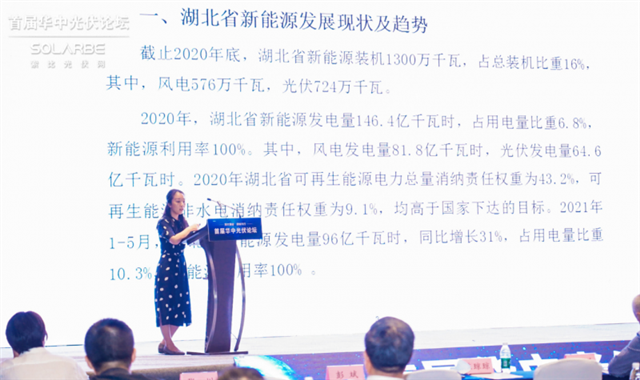
Chen Qiongqiong, deputy director of industry supervision department of Central China Energy Regulatory Bureau (CCERB) of NEA
With the proposal of “reaching carbon emission peak and carbon neutralization”, the new energy industry has entered a year of rapid development. Provinces and cities have successively formulated relevant target plans, and made a key step in the year of the opening of the 14th Five Year Plan period.
After the economic reconstruction of Hubei Province after pandemic, the photovoltaic market has ushered in a historic development opportunity. The central government has gathered the strength of the whole country to support the economic development of Hubei Province, which has effectively promoted the development of new energy in Hubei Province. Chen Qiongqiong, deputy director of industry supervision department of Central China Energy Regulatory Bureau (CCERB) of NEA, said at the First Central China Photovoltaic Forum held last week that the new energy to be put into production in Hubei Province in 2021 will not be less than 3.5 million kilowatts, and it is expected that the newly installation will reach about 15.5 million kilowatts by the end of the year, accounting for nearly 20%.
Chen Qiongqiong stressed that by the end of 2020, 13 million kilowatts of new energy installed in Hubei Province, accounting for 16% of total installed capacity and 7.24 million kilowatts of photovoltaic. The new energy generation capacity is 14.44 billion KWh, with the proportion of electricity occupied by 6.8%, of which the photovoltaic power generation is 6.46 billion KWh. The total renewable energy power consumption responsibility weight is 43.2%, the renewable energy of non-hydropower consumption responsibility weight is 9.1%, which are both higher than the national goal.
Driven by the dual carbon goals, new energy consumption is still an important issue in building a new power system with new energy as the main body. Chen Qiongqiong said that the current problems faced by new energy consumption in Hubei Province mainly include the following three aspects:
The contradiction of new energy power generation regulation is obviously intensified. During the maximum load period of Hubei Power Grid in summer and winter in 2020, the output of new energy only accounts for 9.1% and 1.2% of the load at that time. The maximum daily peak valley difference of new energy output was 4.6 million kilowatts, an increase of 22.3% year on year. The time constraints of photovoltaic power generation and the anti peak regulation characteristics of wind power generation lead to the difficulty of peak regulation. With the continuous rapid development of new energy in the province, the peak regulation pressure of power grid will be further increased.
Besides, the centralized use of clean energy leads to the gradual emergence of transmission channel pressure. In Hubei Province, 96% of hydropower and 60% of new energy are concentrated in the western region, and 60% of power load is concentrated in the eastern region. When the hydropower generation overlaps with the new energy generation, it will directly lead to the heavy load or full load of the west to east power transmission channel in the province. From June to July in 2020, the transmission power of the west to east power transmission channel is basically exhausted. At the same time, the local terminal power grid in cities such as Enshi and Suizhou, due to overly concentrated development of new energy, there is congestion in the main network channel during the period of new energy development.
In addition, some new energy performance can not meet the requirements of “Power System Stability Guidelines”. With the increasing of DC transmission power and the increasing proportion of new energy, frequency stability has become one of the core issues of central China power grid security and stability. New energy stations generally do not have the function of primary frequency regulation, so it is increasingly difficult to control the frequency of power grid. From January to may in this year, there are 12 new energy stations in Hubei Province, with total 36 trips and 154 hours of outage.
In order to promote the development and consumption of new energy, Chen Qiongqiong proposed the following five measures:
a. Give full play to the leading role of planning to promote the coordinated development of grid, source, load and storage;
b. Strengthen the responsibility of renewable energy power consumption in provincial administrative regions;
c. Accelerate the construction of new power system with new energy as the main body;
d. Improve the market transaction and transmission and distribution price mechanism;
e. Land use, taxation, financial and other policy support.
The next step is to modify the trading rules of central China peak regulation auxiliary services, further expand the main body of the market, and introduce new market players, such as energy storage devices, electric vehicles (charging piles), virtual power plants, users of self owned power plants, controllable negative loads to participate in market transactions, relax regulation capacity and adjust power limits. According to the new modes of new energy plus energy storage and conventional thermal power unit plus energy storage, the compensation mechanism for peak shaving and other auxiliary services is further improved, relevant compensation methods are introduced, and users are included in the allocation scope of auxiliary services.
In addition, it is necessary to further improve the auxiliary service market of peak regulation in Hubei Province, expand the market subject to the user side and guide the adjustable load on the user side to participate in peak regulation by combining the construction of dispatching and control system of multi-coordination of source network load and storage and the construction of spot market.


